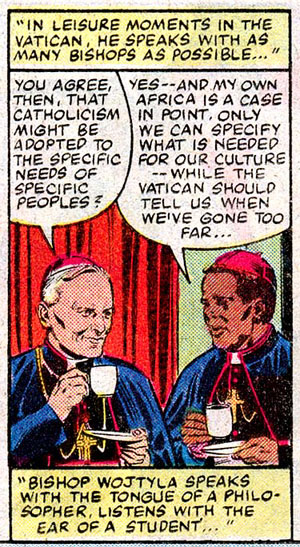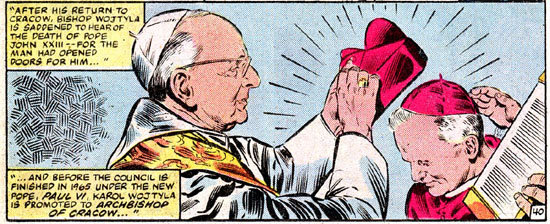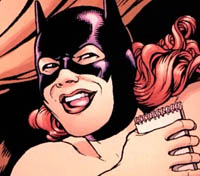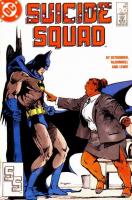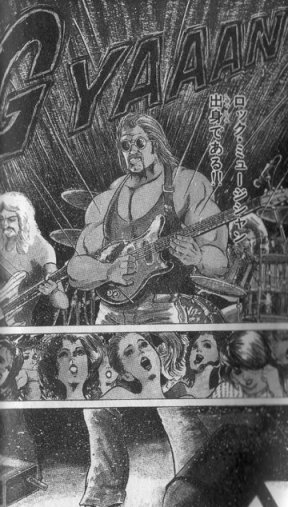(I need a breather after the marathon that was Black History Month, so here’s a guest article for you from Steven “HitTheTargets” Bush. Of course, when I say “breather” I mean “I have to do some hardcore work on Pop Culture Shock.” Anyway, enjoy!)
As a general disclaimer, this is all speculation. It’s based on current events throughout DC universe, so you might be lost if you’re not familiar with things going on in the lead up to Final Crisis.
Thanks to Death of the New Gods we now know the reason for damn near everything that’s happened in the DC universe since the end of Identity Crisis. No, it wasn’t Maxwell Lord’s fault. No, it wasn’t Alexander Luthor’s handiwork. No, it was not even Great Darkseid’s doing. For you see, the intricate, Rube Goldberg-esque plots these fine fellows hatched were themselves all part of another entity’s subtle cosmic master plan. A white beachball with black splotches called The Source (Yes, that The Source) has taken credit for organizing everything done by everyone, including the ones who organized everything that everyone else did. A cunning plan not entirely unlike a Matroska doll that takes years to open and can’t be explained by DC’s editors because that’s what the internet is for. I’m here, on the internet, to explain what I believe to be going on with the birth of the Fifth World.
Here’s a quick primer for anyone not up to speed on the World that’s coming:
Who? The Source, aka The Voice, The Creator. It made everything, it is everything. Looks like a beachball. What? The Fifth World. The point of this article is to figure out what it is. When? May 2008. Countdown ends and the Final Crisis begins. In story terms, creating the Fourth World was hella tiring, and The Source just now woke up. Where? Earth, of all places. It’s been referenced as the birthplace of the Fifth World several times. Why? It’s a mulligan. The Fourth World is like a sequel without the original cast & crew, so The Source wants a do-over. How? Making Nth Worlds is basically what The Source does. So the question here is not how it does that, but how it does that right. In short, The Source needs its groove back.
Of course, the true architect of the Fifth World is Grant Morrison, with help from Geoff Johns & Dan Didio. The story of Final Crisis is the story of the Fifth World’s birth.
At this point, I should probably lay out everything we know about how the Fifth World will come to be. As mentioned, the problem is that while The Source can normally make Worlds no prob’, right now he isn’t one hundred percent. A long time ago The Source created the Old Gods, then they got uppity and slapped the black outta him (seriously, they zapped him and a black beachball popped out), so he killed ’em all and created the New Gods. But he was missing half of his essence, his being, and they just didn’t measure up. Now he wants to become whole and do it proper, but there’s one problem: the black ball fell through dimensions and the Crisis on Infinite Earths created some kinda… solid… dimension… thing. Um… Yeah… OK, how about this? It fell in a lake, and CoIE froze the lake. That works. So The Source does what we’d all do in that situation; it manipulates Alexander Luthor, Conner Kent, Rip Hunter, and Mr. Mind to create 52 unique universes, thereby thinning the ice or something like that. The Source is currently on the final step of its plan; harvesting the souls of the New Gods in order to power the merger itself and then to act as raw material in the creation of the new World.
Okay, so let’s say black & white reunite, and The Source do the voodoo he do. Bang! Fresh squeezed Fifth World. What I think will happen here is basically that The Source will take the existing New Gods and raise them up as a new, complete mythology rather than just being superheroes from space. To elaborate, let’s look at the Greek gods as portrayed in the DCU. They’re home is cut off from access to all but the most powerful magicians, they each have power enough to rival high level beings like the Oans, and they never directly interact with mortals, instead sending out champions like Wonder Woman or Hercules. Yes, Granny Goodness did appear in the form of Athena and magically depower all the Amazons at the end of Amazons Attack, buy she did it with power stolen from the real deal. By contrast, the New Gods more closely resemble Marvel’s Greek gods. They live in another world but all it takes is a spaceship with inter-dimensional capabilities to get there, they’re powerful enough solo to match most Earthly powers but not any cosmic beings like Galactus, and Ares himself is a member of the Avengers. Boom tubes seem to float around Earth’s black market and the Guardians have Green Lanterns there just like any other space sector. Although he does have the Omega Effect, Darkseid is more or less even with Superman in a slugfest. Mr. Miracle, and Barda have a permanent home in the suburbia, and along with Orion have been JLA members.
If you regularly follow rumors in the comic book industry, superpeople ascending to an even higher existance may sound slightly familiar. There was at one time a rumor saying that Earth’s superheroes would be elevated to the level of gods, with Superman, Batman, and Wonder Woman as the ruling trinity. And even though Earth is the birthplace of the Fifth World, common sense tells us the writers would never fuck with the status quo like that. But we know for sure Earth is more than involved, it’s where everything happens. My guess is the reason for this reinvention is to bring the Fourth World saga closer to home. If the new mythology is centered on Earth, writers and readers will be more interested in exploring it than if we stick it in some far off corner of space. I’ve heard a lot of mentions of “sides” of the DCU: the magic side, the space side, the political side, the criminal underworld. I think Final Crisis will be introducing a God side.
The best clue to the exact relationship of Earth and the Fifth World is in Morrison’s Seven Soldiers: Mister Miracle. Shilo Norman drops into a black hole and winds up in a world where the New Gods possess human bodies. From what we’re shown, the gods of New Genesis are only dimly aware of this and live in squalor, although Shilo briefly “awakens” Metron. The Apokolipsian gods are still themselves, they just seem to be using humans as host bodies or avatars. I suspect this is a glimpse at the Fifth World. A higher plane centered around New Earth where the New Gods will reside, now as truly godlike beings. If they have reason to act on Earth, it’s in the form of living fictionsuits. The Gods of New Genesis are stuck here though, giving Dark Side free reign.
An interesting thing to note here is that the Mister Miracle issues of Seven Soldiers have very little to do with the Sheeda invasion. They’re there to prepare him for his role as the champion of New Genesis after the advent of the Fifth World and Darkseid’s triumph. Darkseid allows the Sheeda to attack in exchange for Aurakles, forcing Shilo to exchange himself for demi-god. That’s it. That’s his role as a Soldier; freeing Aurakles to let him fight the Sheeda. After doing that, Shilo is shot in the head and the very last page of the Seven Soldiers #1 shows his hands breaking out his grave, now in the art style used to represent the gods in their real, otherworldly form. In his role as New Genesis’s chosen one, Shilo is to truly reawaken the good Gods and prevent Darkseid from achieving total domination. In short, the book is a prelude to Final Crisis and only connects to the Sheeda story when Darkseid takes advantage of their presence in order to destroy Shilo, the one person who can threaten him.
The explanation for why the Dark Side rules and the good gods are powerless is found in the lead up to Final Crisis. That’s right, Countdown. It may not be very good, but its raison d’etre is to foreshadow the events in Final Crisis while reflecting goings-on in the DC universe as a whole. Every subplot is connected to Apokolips (Even Piper & Trickster somehow) For reasons unknown, Jimmy Olsen is acting as a soul-catcher, of sorts, and has within him the gods killed in Death of the New Gods. Since these god-souls are essential to The Source’s goals, Jimmy manifests convenient superpowers whenever his life is in danger. Meanwhile, Darkseid plans to unleash a biological weapon on Earth, I surmise specifically to get at Jimmy, in what will be called the Great Disaster. Here’s the tricky bit: The weapon doesn’t exist yet. Darkseid has manipulated Karate Kid into visiting Brother Eye, and given Eye some New God tech to bring the whole gang to Apokolips. There he will combine the Kid’s virus with the Soul Fire Serum. The Source is countering this by sending the Challengers of the Beyond after Ray Palmer, who knows how to stop said virus, and then sending that group to Apokolips. I can’t be sure exactly what happens next, but presumably the state of the New Genesis gods post-Fifth World is a result of the mutated virus’s ability to fatally expand consciousness and Ray’s cure, which would only be partially effective against the new strain.
Assuming any of this is right, it’ll be awhile before we really get to see it. Final Crisis begins in May and runs for seven oversized issues. Like Infinite Crisis’ introduction of New Earth and 52’s debut of the new Multiverse, FC will probably only show the barebones of the Fifth World, letting other writers expand and explore the new mythology. Morrison did use a pantheon scheme in his Justice League and I’d imagine that sort of thing would make a comeback in a major way in a story about actual Gods, so perhaps we’ll see who’s who among the New New Gods. The possibilities beyond that are wide open, as you’d expect not only from Grant Morrison, but also from a true life mythology. I look forward to these new story opportunities giving rise to Legends.

